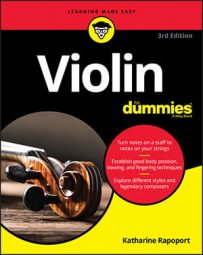One piece of gear that you can change up with relative ease is your violin bow. Upgrading a bow is much more reasonable in cost than buying a fancier violin, and it can make a significant difference to your sound quality and your playing experience.
When you try out a few bows, you immediately realize that there’s a considerable difference between one stick and another in terms of weight, balance, and the feel of the frog in your hand. Human hands are so sensitive that they can notice even a subtle difference in the diameter of the stick or the shape of the frog. And your ears and hands have preferences! Ask the assistant in the violin store to play the different bows for you on your own violin so you can hear the interaction as you sit at the other end of the room.
There’s no science (yet!) to matching a violin and bow for best sound, but luckily you have lots of choice and can find the best combination — if you’re prepared to keep an open mind and some alert ears. Here’s some advice for trying out bows:
Make sure the bows you’re trying have a full, evenly distributed ribbon of horsehair running all the way across the frog and that they have enough rosin on to draw a clear sound from your violin.
Try several bows in your price range by playing long, smooth strokes on each string of your violin. And if you don't like the sound of a particular bow, set it aside and try another.
After you’ve narrowed down your choices based on sound to three or four favorite bows, move on to the second round of trying them, again taking some long calm strokes on each bow, to have a closer look and listen. If the bow has any weak or wobbly spots in the stick, or some unevenness, you’ll often find that you can feel this problem at the same spot on each stroke, and you should put the bow aside.
Try some strong martele strokes and then some off-the-string strokes; you may have to search a bit for the spot, usually just below the midpoint of the stick, where the bow bounces best — the exact spot varies from bow to bow.
Does the weight of the bow feel right to you? Don't worry too much about the bow’s numerical weight in grams, because balance can greatly affect the overall feel of each bow.
When you’ve found a couple of bows that seem to work for you, it’s then important to play them at home, show them to your teacher, and try them when playing with friends. Give yourself time to get used to a bow and to learn what it can and can't do. Most stores will let you take a couple of selected bows home for a week on approval before you choose The One!
There’s not a definitive ideal bow type or make that suits every player and every instrument. A bow that makes one violin sing with a beautiful full sound, for example, may sound very dull on another. Likewise, a bow that is supple and light may be perfect for some players but probably won’t work for someone who plays with a lot of weight on the bow. It’s not a matter of which is better; it’s just that they’re different.
Look at the following elements when considering bows:
Materials: Fine bows are traditionally made from pernambuco, a very strong, dense wood from Brazil. Its strength and resonant qualities are what make it the best material for bows. But it’s getting rare and it’s expensive, so many bow makers are trying to find an acceptable substitute for pernambuco. At this time, carbon-fiber bows have been the most successful alternative, so a good-quality carbon-fiber bow is worth considering.
Grain: The grain of the wood should run fairly straight along the length of the bow-stick, especially in the upper part of the bow near the tip. Straight-grained wood lessens the possibility of a broken stick or tip.
Frog: The frog should fit well on the stick, without too much side-to-side movement, and should slide freely back and forth when you tighten and loosen the bow. The end-button should turn freely.
Curve: When you tighten up the bow, the camber (curve of the stick) should be smooth and even with no kinks or flat spots.
Weight: The weight of a violin bow is usually in the range of 58–65 grams. The balance of the bow is also an important factor and can affect the feel of a bow at least as much as, if not more than, the weight. How it feels in your hand is what’s most important.
Strength or stiffness: When a bow is tightened for playing, the stick should not hit the strings when normal playing pressure is applied. What’s normal bow pressure can vary a lot from player to player, and good bows can range from quite flexible to very resistant.

